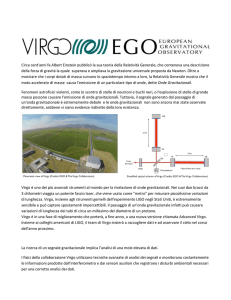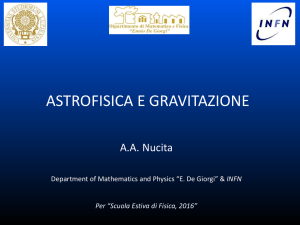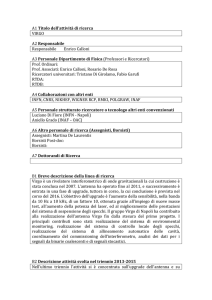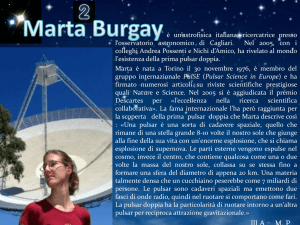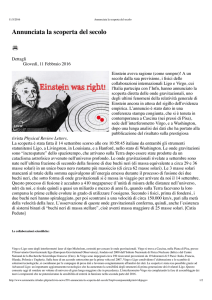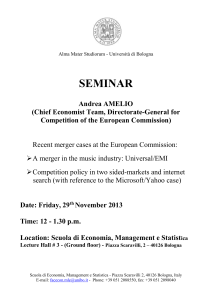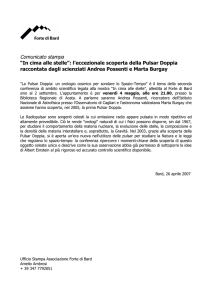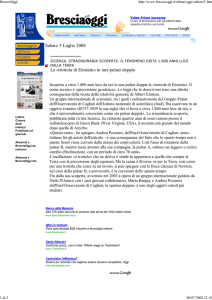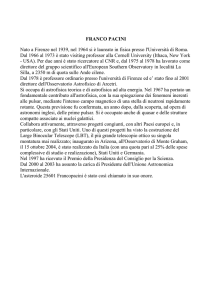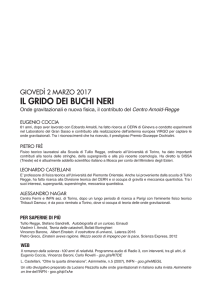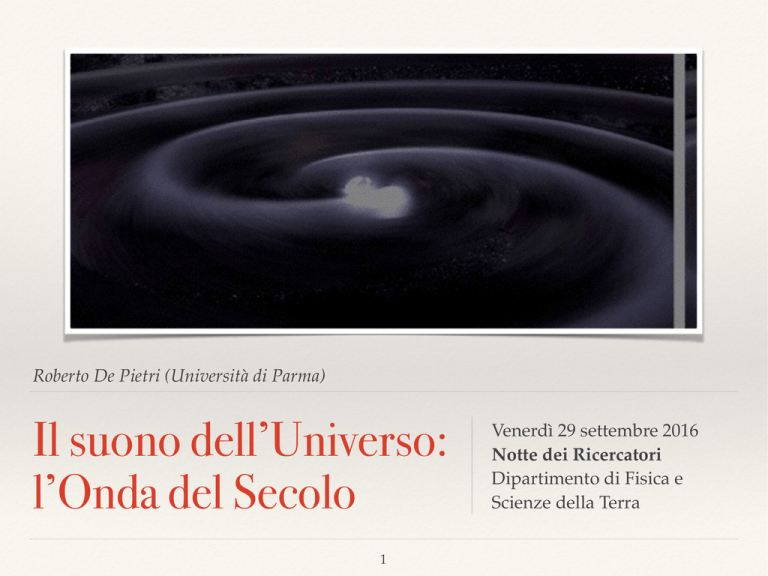
Roberto De Pietri (Università di Parma)
Il suono dell’Universo:
l’Onda del Secolo
1
Venerdì 29 settembre 2016
Notte dei Ricercatori
Dipartimento di Fisica e
Scienze della Terra
Relatività Generale
➡
La gravità si mostra come conseguenza del fatto
che lo spazio tempo è curvo !
๏
Ogni massa-energia curva lo spazio tempo
๏
Gli oggetti in caduta libera seguono le
geodetiche (rette) dello spazio curvo
๏
Le equazioni di campo sono:
Rµ⌫
➡
1
8⇡G
gµ⌫ R = 4 Tµ⌫
2
c
C’é uno spazio-tempo assoluto, ma siamo liberi
di scegliere il sistema di riferimento (sistema-dicarte) che usiamo per descrivere le leggi della
fisica.
๏
L’invarianza di gauge della teoria si manifesta
nella libertà di scegliere il sistema di
riferimento (invarianza per diffeomorfismi
attivi e passivi)
2
La croce di “Einstein”
❖
Croce di Einstein è il nome dato
all'immagine prodotta dalla galassia ZW
2237 +030 e del Quasar G2237 +0305
collocato direttamente dietro ad essa. La
galassia, scoperta dall'astronomo John
Huchra e distante 400 milioni di a.l. dalla
Terra, agisce da lente gravitazionale nei
confronti della luce emessa dal quasar circa
8 miliardi di anni luce dietro ad essa,
producendo così la caratteristica immagine
a croce. In tale immagine, i quattro bracci
della croce corrispondono alla luce del
quasar deviata per effetto del campo
gravitazionale della galassia visibile al
centro della croce come zona luminosa
relativamente più diffusa e meno intensa.
3
Micro-Lenti Gravitazionali
Microlensing — lo spazio-tempo si comporta come una lente …. sfuocata ….
4
Il suono
❖
Dal dizionario si vede che il suono è definito come la sensazione acustica prodotta dalle
vibrazioni di un corpo eccitato, trasmesse attraverso l'aria; si dice soprattutto a proposito
della voce umana, di strumenti musicali e simili, e nella nostra concezione necessità di un
mezzo per essere trasmesso e udito. Ma noi sappiamo che oltre la terra non c’è aria e
quindi abbiamo l’idea che l’universo sia “muto”.
❖
Quello di cui voglio parlarvi oggi è convincervi che la gravità modifica lo spazio che ci
circonda e le sue alterazioni o “increspature” sono in grado di mettere in vibrazione un
corpo e così siamo (saremo) in grado di sentire il suono dello spazio che ci circonda.
5
Cosa sono le onde gravitazionali ?
❖
Le onde gravitazionali sono vibrazioni dello spazio-tempo
(le onde elettromagnetiche sono vibrazioni elettromagnetiche nello
spazio-tempo)
❖
Si possono rivelare ? Si perché se lo spazio
si accorcia/allunga con l’onda … … posso misurare queste oscillazioni … o .. come mette in vibrazione un corpo solido
o .. misurando l’interferenza in un interferometro di Michelson-Morley
….
λ / 100
~ 5 nm
6
Michelson, Morle
y 1887
Possiamo sentire il suono dell’universo ?
❖
Lo spazio-tempo può oscillare e chiamiamo le sue
oscillazioni onde-gravitazionali.
❖
Queste vibrazioni possono essere definite come il suono
dell’universo !
❖
Domanda 1: POSSIAMO SENTIRE QUESTE VIBRAZIONI
DELLO SPAZIO E DEL TEMPO ?
❖
Domanda 2: CI SONO DELLE SORGENTI DI VIBRAZIONI
DELLO SPAZIO E DEL TEMPO SUFFICIENTEMENTE
INTENSE DA ESSERE “UDIBILI SULLA TERRA” ?
7
Il cielo è più vario e complesso……
❖
Il campo ultra profondo di Hubble
(abbreviato in HUDF dalle iniziali del
nome inglese, Hubble Ultra Deep
Field), è l'immagine di una piccola
regione dello spazio nella costellazione
della Fornace, composta grazie ai dati
raccolti dal telescopio spaziale Hubble
nel periodo dal 3 settembre 2003 al 16
gennaio 2004. Essa è la più profonda
immagine dell'universo mai raccolta
nello spettro della luce visibile, e
permette di guardare indietro nel
tempo per 13 miliardi di anni. Si stima
che la HUDF contenga 10000 galassie.
La piccola porzione di cielo nella quale
cade il campo ultra profondo di Hubble
(appena un decimo del diametro della
luna piena osservando dalla Terra) è
stata scelta perché ha una bassa densità
di stelle luminose nelle vicinanze.
http://it.wikipedia.org/wiki/Campo_ultra_profondo_di_Hubble
8
Galassie in collisione ….
Extreme Mass-Ratio Inspirals: EMRIs
❖
• Stellar-mass BH capture by a
BH:di
dozens
per year to
che almassive
centro
ogni
z~0.7.
Noi pensiamo
galassia ci sia un “buco-nero”
di massa
5
• 10 orbits very close to horizon.
GRACE/GOCE
for massive
BHs.
pari a 1.000.000 di volte
la massa
del sole.
– Prove horizon exists.
❖
Se due galassie collidono
i buchi
neri al
– Test the
no-hair theorem
to 1%.
loro centro collidono–……
Masses of holes to 0.1%
Super-massive
black-hole
mergers
– Spin of central BH
to 0.001.
• Probes environment of central
black-hole
– mass and spin spectrum of
stellar mass black holes
– density and mechanism of
formation
Wuhan, February 11, 2014
Arp 299
NGC6240
S. Vitale
Abell 400
9
23
NGC 3393
Sorgenti più probabili (PULSAR)
❖
PULSAR: sono costituite da stelle di
neutroni (materia nucleare neutra) rotanti.
Sono oggetti compatti a rapida rotazione
e caratterizzate da campi magnetici
intensissimi e sono il resto delle
esplosioni di supernova.
❖
Raggio ~ 10 km
❖
Massa ~ 1.4 la massa del sole
❖
Periodo di rotazione tra circa ~1.4 ms
e 8.5 s
❖
Campo magnetico B dell’ordine di ~
8
14
10 – 10 Gauss
❖
Emissione pulsata visibile nelle onde
radio, (ottiche), raggi X e raggi gamma.
10
PULSAR al millisecondo
❖
Delle circa 30.000 PULSAR che sono rilevabili,
ne sono conosciute circa 2000 (circa 200 nella
nostra galassia) che hanno un periodo di
rotazione dell’ordine del millisecondo MSP (P
< 20 ms). Le MSP galattiche sono locali (d ~
kly) e sono distribuite in modo omogeneo.
Sono dei rotatori
incredibilmente stabili
e questo fa di loro dei
laboratori eccellenti
per verificare la fisica
fondamentale
11
GW DO EXIST
Hulse & Taylor Nobel 1993
PSR1913+16: pulsar bound to a “dark Prova indiretta •dell’esistenza
delle
companion”, 7 kpc from Earth
• Relativistic
clock: v /c binarie
10
onde gravitazionali
da
sorgenti
• GR predicts such a system to loose
max
❖
energy via GW emission: orbital
Fitted Parameter
decrease
Si veda: J. M. Weisberg, J.H.period
Taylor,
“Relativistic
Ap sin(i)
Radiative
prediction
of general
Binary Pulsar B1913+16: •Thirty
Years
of
e
relativity verified at 0.2% level [astro-
Observations and Analysis”ph/0407149]
arXiv:astro-ph/
0407149.
P (d)
❖
0322997448930(4)
La predizione della relatività
generale 4.226595(5)
per (dPb/
d /dt (deg/yr)
-12
dt) è: -2.40242(2) 10
M
1.4414 ± 0.0002 M
p
❖
-3
Mc
1.3867 ± 0.0002 M
0.6171338 (4)
T0 (MJD)
52144.90097844 (5)
Pb (d)
0.322997448930 (4)
⍵0 (deg)
292.54487 (8)
<d⍵/dt> (deg/yr)
4.226595 (5)
0.0042919 (8)
𝛾 (s)
dPb/dt4 (10-12 s/s)
−2.4184 (9)
Weisberg & Taylor
E’ necessario tener conto della correzione dovuta
Feb 17, 2014
all’accelerazione relativaINFN
traGenova,
il sistema
solare edG Losurdo
il - INFN Firenze
sistema binario: il valore corretto di dPb/dt è: -12
2.4056(51) 10 .
Il termine correttivo dipende da quantità non note
con sufficiente precisione come la distanza ed il
moto proprio della pulsar ed il raggio dell’orbita
galattica del sole.
12
Value
2.3417725 (8)
3
Relativistic Binary Pulsar B1913+16
measured orbital parameter, Ṗb , overdetermines the system dynamically
thus provides a test of gravitation theory.
3.1.
Emission of Gravitational Radiation
According to general relativity, a binary star system should emit energy in
form of gravitational waves. The loss of orbital energy results in shrinkag
the orbit, which is most easily observed as a decrease in orbital period. P
& Matthews (1963) showed that in general relativity the rate of period decr
is given by
192 π G5/3 Pb −5/3
(1 − e2 )−7/2 ×
5 c5
2π
"
!
37
73
1 + e2 + e4 mp mc (mp + mc )−1/3 .
24
96
Ṗb,GR = −
!
"
Note that except for Newton’s constant G and the speed of light c
quantities on the right hand side of Eq. (1) have measured values listed in T
1, or, in the case of the component masses, are derivable from those quant
The predicted orbital period derivative due to gravitational radiation comp
−12
Il destino della Pulsar B1913+16
❖
Ammettendo onde
gravitazionali l’orbita delle
due stelle di neutroni si
avvicineranno sempre di più
fino a fondersi in un unica
stella di neutroni che poi
(probabilmente) collasserà a
formare un buco nero.
❖
Il processo richiederà
milioni di anni ()
❖
Possiamo simulare
numericamente il suo
destino.
❖
(Simulazione numerica fatta
dal gruppo di Parma)
A. Feo, R. De Pietri, F. Maione and F. Loeffler, Modeling Mergers of Known Galactic Systems of
Binary Neutron Stars. arXiv:1608.02810. Classical
and Quantum Gravity (to appear)
13
Cosa avviene: una simulazione numerica…
R. De Pietri, A. Feo, F. Maione and F. Loeffler, Modeling Equal and Unequal Mass Binary
Neutron Star Mergers Using Public Codes. Phys. Rev. D 93, 064047 arXiv:1509.08804.
Pulsar
Mp
(M§ )
J1756-2251 1.341(7)
J0737-3039A 1.3381(7)
J1906+0746 1.291(11)
B1534+12
1.3330(2)
J0453+1559 1.559(5)
B1913+16
1.4398(2)
Mc
(M§ )
1.230(7)
1.2489(7)
1.322(11)
1.3454(2)
1.174(4)
1.3886(2)
q
e
0.92
0.93
0.98
0.99
0.75
0.96
0.18056
0.08778
0.08530
0.27368
0.11252
0.61713
6 sistemi galattici noti …
tmerger
(Gyr)
15.85
0.08
0.32
2.51
14.55
0.32
e10
at 10 Hz
7.20 ◊ 10≠7
1.11 ◊ 10≠6
6.48 ◊ 10≠7
8.85 ◊ 10≠8
1.14 ◊ 10≠8
5.32 ◊ 10≠6
M (1)
(M§ )
1.33
1.36
1.41
1.46
1.27
1.53
M (2)
(M§ )
1.47
1.47
1.45
1.47
1.74
1.59
eID
MADM
J
2
(krad/s) (M§ ) (GM§
/c)
0.022 1.773 2.548
6.654
0.023 1.777 2.564
6.728
0.024 1.784 2.589
6.848
0.025 1.801 2.653
7.136
0.030 1.816 2.708
7.238
0.025 1.840 2.801
7.816
Reference
[11]
[12, 13]
[14, 15]
[16, 17]
[10]
[8, 9]
TABLE I. Known BNSs in our galaxy, as appearing in Ref.[10]. Mp is the mass of the pulsar that denotes the system and
Mc the mass of its companion, q represents the mass ratio, and e the eccentricity. tmerger is the merger time of the system
computed using Eq. (7) of [18], and e10 is the eccentricity when the rotation frequency of the system is 10 Hz, computed using
Eq. (1.2) of [19]. The remaining columns represent the properties of the initial data used to model the BNS system using the
❖ A
secondo
massa
duebaryonic masses, eID is the measured eccentricity, the initial rotation frequency,
SLy
EOS,
where della
M (1) and
M (2)delle
are the
MADM
the di
ADM
mass of avranno
the systemuna
and J its angular momentum.
stelle
Neutroni
diversa dinamica ed un diverso
destino.
systems,
the properties of the remnants, and the effect
University.
In order to describe BNS systems we need to use the
Einstein’s general relativity equations to describe the
metric gµ‹ of the dynamical spacetime
of the EOS for the case of J0453+1559. A summary and
❖ Il segnale rivelato dipende dal
conclusions
are given in Sec. IV.
di stato
Indettaglio
this workdell’equazione
we use a space-like
signature ≠, +, +, +,
withche
Greek
indicesla running
0 to 3, Latin indices
descrive
materiafrom
(a densità
1
8fiG
fromnucleare)
1 to 3, andpresente
the standard
convention
for
summation
Rµ‹ ≠ gµ‹ R = 4 Tµ‹ .
(1)
nella stella di
2
c
over repeated indices. The computations are performed
Neutroni.
using
the standard 3 + 1 split into (usually) space-like coThe dynamical evolution is described using the Einordinates (x, y, z) = xi and a time-like coordinate t. Our
❖ Il segnale gravitazionale
stein Toolkit, which is a publicly available, communitycoordinate
system (xµ ) = (t, xifornirà
) = (t, x, y, z) (far-from
driven general relativistic code.
In particular, we
proprietà
della
the indicazioni
origin) are, assulle
it can
be checked,
almost isotropic cohave chosen the eleventh release (code name “Hilbert”,
ordinates
and
(far-from
the
origin)
they
would
have
the
materia in queste condizioni
ET_2015_05). The ET is based on the Cactus comusual
measure
unit
of
“time”
and
“space”
and
in
particextreme che non sono
putational toolkit [37–39], a software for high perforular t is close to be identified as the time measured from
mance computing that uses: the adaptive mesh refinesperimentalmente
accessibili
sulla are performed
an observer
at infinity. All
computations
ment (AMR) methods implemented by Carpet [40–42].
terra.
(SUONO!)
in normalized
computational units (hereafter denoted as
In particular, the initial data is discretized on a CarteA. Feo, R. De Pietri, F. Maione and F. Loeffler, Modeling Mergers of Known Galactic Systems of Binary Neutron
CU) in which c = G = M§ = 1. We report the radius
sianStars.
grid
with 6Classical
levels
of mesh
refinement.
The inarXiv:1608.02810.
and Quantum
Gravity
(to appear)
of the sphere used for gravitational waves extraction in15
ner level contains a grid with a spacing of dx = 0.25
m and represent the frequencies of the main and secondary
aks of the PSD (bottom-right panel of Fig. 3). Notice that
1.0
1.0
do not 1.0include the sixth galactic
system (B1913+16)
as it
J1756-2251
J0737-3039A
M
= 2.564
pidly goes
to a BH.M = 2.548
0.5
0.5
0.5
4
FIG. 4. Evolution of the total energy momentum (Egw )
M ried
= 2.589 away by gravitational radiation in solar mass as a fu
q = 0.92
q = 0.93
q = 0.98
tion of the retarded time tret , for the six different BNS mod
0.0
0.0
0.0
The colored circles mark the merger time for each mode
indicated in Table III.
0.5
0.5
hose PSD
rapidly decays to0.5zero as the pulsar collapses
ADM
r · h22 (km)
r · h22 (km)
ADM
r · h22 (km)
ADM
J1906+0746
Segnale gravitazionale dai 6
sistemi binari di stelle di neutroni
noti presenti nella nostra galassia
a BH soon after the merger. Also, J0453+1559 does
Egw
Egw
Egw tmerger
t follow this trend due to its very low q = 0.75 value,
Model
(M§ ) (M§ ) (M§ ) (ms)
hich renders this system quite different from the others.
[. . . -5] [-5. . . 5] [5. . . 20]
B1534+12
J0453+1559
B1913+16
Some of the models
show other, secondary
post=
=
=
J1756-2251 0.0276 0.0488 0.0189 15.3
=
=
=
ergers peaks at frequencies f≠ and f+ (also known as
J0737-3039A 0.0277 0.0528 0.0255 15.1
and f3 in the literature) that can be seen in Fig.3.
J1906+0746 0.0282 0.0582 0.0148 14.0
hey are also recognizable from the spectrum and may
B1534+12
0.0297 0.0597 0.0192 13.9
J0453+1559 0.0287 0.0269 0.0060 11.8
lp to extract NS parameters (radius, mass) from GW
B1913+16
0.0317 0.0276 6 · 10≠7 11.8
tections [63, 64]. In Table II we report the frequencies
all recognizable spectral peaks for the BNS systems of
TABLE III. For each model·0is reported
f0
fp the
fˆptotal
f≠ energy
f+ em
g. 3. 6
10
Model
(kHz)separation
(kHz) (kHz) (kHz)
ted as gravitational waves (ms)
from(kHz)
infinite
up to 5
J1756-2251
J0737-3039A exhibiting
J1906+0746 these threeJ1756-2251
One of5 the
systems clearly
peaks
7
J1756-2251
2.49 1.148
2.028
4.280 u
J0737-3039A
before merger (second
column),
from3.163
5 ms3.114
before
merger
4
J0737-3039A 2.74 1.139 3.293 3.182 2.105 4.271
J1906+0746
B1534+12,
with the middle peak fp and
two
sec3
5
ms
after
merger
(third column)
from
5 ms
6
B1534+12
J1906+0746
2.72 1.119and
3.326
3.231
2.206after
4.321mer
dary 2peaks in both sides of the principal frequency.
J0453+1559
B1534+12
3.72 0.984
3.667 3.424
2.459fifth
4.397colu
up to 20 ms after
merger (forth
column).
In the
5
1
B1913+16
J0453+1559
2.54in0.998
—
— refe
he same three peaks can be observed for models J1756is reported the merger
time
ms. 3.331
All 3.268
these values
10 0 10 20
10 0 10 20
10
0
10
4
51, J0737-3039A
and
J1909+0746.
See Table
II for
simulations performed
with
dx damping
= 0.25times
CU of(ƒ
TABLE II. Main
peakresolution
frequencies and
th
t
t
(ms)
t
t
(ms)
t
t
(ms)
6
post-merger phase of the simulated models at dx = 0.25 CU
m).
eir specific
frequencies.
It should
be noted
that the
3
B1534+12
J0453+1559
B1913+16
5
·0 andA.f0Feo,
are the
dumping
and the and
frequency
of the oscil
R. De
Pietri,time
F. Maione
F. Loeffler,
condary
peaks
f
decays
within
few
ms
as
it
can
be
±
4
lation of the
lapse – between
1.5
to 8 ms after
tmerger , respec
2
Modeling
Mergers
of
Known
Galactic
3
tively. The frequency fp is determined by a single-frequency
en in the
spectrograms (bottom-left) of Fig. 3.
Systems on
of the
Binary
Neutron
2
1
fitting procedure
last part
of h22Stars.
signal.arXiv:
The frequen
since it is well
known
that
differentially
rotating
st
On the
1 other hand, this three-peak-structure does not
ˆ
1608.02810.
Classical
and
Quantum
Gravity
cies, fp , f≠ , f+ , are derived by an analysis of the Fourier spec
0
FIG. up
3. Overview
of the models
studied using
the SLy EOS. These
models are J0453+1559,
J1756-2251,
J0737-3039A,
(toand
appear)
trum
and
represent the frequencies
of thethe
main threshold
and secondary
show
dynamical
instabilities,
that
ow
in
of
10 the
0 10 case
20
10 0the
10 J0453+1559
20
10 5 0 5 10(q = 0.75).
0
1 This2
3
4
5
B1913+16, J1906+0746, B1534+12, with unequal mass ratios of q = 0.75, 0.92, 0.93, 0.96, 0.98, 0.99, respectively. We report in
peaks of the PSD (bottom-right panel of Fig. 3). Notice tha
t
(ms)
t
(ms)
t
t
f (kHz)
the top panel tthe amplitudes
of
thet main
l = 2,
m = of
2 mode
of the (ms)
gravitational
wave signal,
in the bottom-left
panelactivation
the
their
depends on the EOS (see [65–69] a
consistent
with
the
results
Ref.
[32], where
itandhas
we do not include the sixth galactic system (B1913+16) as i
corresponding spectrogram. In the bottom-right panel we show the corresponding power spectral density for the six systems
FIG.
3. Overview
of where
the models
studied
using
the SLyonEOS.
Thesegoing
models
rapidly goes to a BH.
at a distance
of 50 Mpc,
the Fourier
transform
is computed
the interval
from are
9 ms J0453+1559,
before merger
toJ1756-2251,
12 ms after J0737-3039A,
reference
therein).
en
shown
that
the
three-peak-structure
is
gradually
B1913+16,
J1906+0746,
B1534+12,
with
unequal
mass
ratios
of
q
=
0.75,
0.92,
0.93,
0.96,
0.98,
0.99,
respectively.
We
report in
merger.
the
top
panel
the
amplitudes
of
the
main
l
=
2,
m
=
2
mode
of
the
gravitational
wave
signal,
and
in
the
bottom-left
panel
ppressed for unequal mass BNS systems. A similar be- 16
In addition tothehydrodynamical quantities, we also a
1.0
1.0
10
0
tret
10
20
tmerger (ms)
30
10
1.0
0
tret
10
20
tmerger (ms)
30
15
1.0
2.653
0.0
MADM
0.5
0.99
r · h22 (km)
q
q
2.708
0.0
0.5
1.0
1.0
1.0
10 20 30 40
tret tmerger (ms)
50
20
10
0
tret
10
20
tmerger (ms)
MADM
q
2.801
0.96
0.0
0.5
0
5 0
5 10 15
tret tmerger (ms)
0.5
0.75
0.5
10
10
1.0
r · h22 (km)
MADM
0.5
r · h22 (km)
1.0
30
10
0
tret
10
20
tmerger (ms)
30
merger
ret
merger
ret
merger
ret
merger
ret
merger
ret
merger
f (kHz)
ret
2| h̃( f )| · f 1/2 (Hz
1/2 )
@50Mpc
f (kHz)
23
corresponding spectrogram. In the bottom-right panel we show the corresponding power spectral density for the six systems
Problema: le sorgenti sono estremamente deboli
Alcuni Numeri …
VIRGO cluster
Il cluster di galassie Virgo
distante 50 million di anni luce
(15Mpc)
tà
i
s
en
t
n
I
h = ΔL / L
hring ~ 1/ 5
pio
In questo esem
hh
NS Binary
o d i stelle
Da un sistema binari
d i neutroni
hNS ~ 10
Binary NS coalescence
−22
E’
€
Time
17
b
u ra
s
i
m
ile?
Lo spettro gravitazionale…..
Cosmic Strings
Supernovae
BH and NS Binaries
Relic radiation
Extreme Mass Ratio
Inspirals
Supermassive BH Binaries
Spinning NS
Binaries coalescences
10-16 Hz
Inflation Probe
10-9 Hz
10-4 Hz
Pulsar timing
Space detectors
18
100 Hz
103 Hz
Ground interferometers
Un onda gravitazionale è una distorsione dello spazio-tempo !
❖
Può essere vista come un cambio della distanza tra masse
stazionarie (inerziali=in caduta libera)
❖
Lo spostamento è proporzionale alla sua lunghezza
❖
Noi sappiamo come misurare spostamenti (l/100 - 5nm)
Michelson, Morle
y
-14
❖
L=10cm, 10mW => hTT ~ 10 .
❖
Come migliorare:
❖
andare sul punto di nero
❖
fare circolare più potenza
❖
allungare i bracci
bracci di alcuni chilometri
~15 kiloWatt di potenza nei bracci
NPRO CW Laser
Nd:YaG @ 1064nm
19
A network of advanced detector
GEO
VIRGO
LIGO H1
LIGO L1
KAGRA
LIGO-India
20
La sensibilità LIGO/VIRGO/GEO600 generazione 1
❖
❖
LIGO, VIRGO e GEO condividono tutti i
loro dati per formare un network
globale di rivelatori.
Dal 2006 sono stati raccolti
congiuntamente 2 anni di dati
GEO
LIGO: H1, L1
❖
La LIGO/VIRGO collaborazione
include 50 università e più di 800
ricercatori. L’INFN gestisce direttamente
l’esperimento VIRGO a PISA !
❖
+100 articoli pubblicati
❖
Nessuna rivelazione (forse 1 ?)
Virgo
21
Nuova sensibilità: incremento di 10 volte dell’orizzonte
(Considerando solo l’unione/fusione di stelle di neutroni)
❖
Questi eventi avvengono una volta ogni 10.000 anni nella nostra
galassia.
❖
Prima generazione (solo 100 galassie)
❖
Ragionevole aspettarsene 1 al mese!
(con gli “Advanced detector” …)
❖
VIRGO/LIGO (H1,L1)
Virgo Cluster
50 million light-years away
(15Mpc)
NS Binary
Per binarie nel cluster
Virgo il segnale è:
hNS ~ 10
−22
22
La
sensibilità
della
nuova
generazione
SENSITIVITY OF THE ADVANCED LIGO DETECTORS AT …
TABLE II. The l
the requirements f
ferometric degrees
Degree of freedom
Common arm leng
Differential arm le
Power recycling ca
Michelson length
Signal recycling ca
and control system
Pound-Drever-Ha
PHYSICAL REVIEW
D 93, 112004 (2016)
Sensitivity of thehomodyne
Advanced LIGO detec
detectors at the beginning of
Table II shows l
gravitational wave astronomy
FIG. 2. The strain sensitivity for the LIGO
23 Livingston detector
root-mean-square
Cosa ha sentito LIGO…..
❖
Le onde gravitazionali sono state rivelate (sentite)
per la prima volta il 14 settembre 2015 alle 09:51
UTC dai rivelatori di entrambi gli interferometri
laser degli osservatori gravitazionali (gemelli)
presenti in Livingston, (Louisiana) ed ad Hanford
(Washington) negli stati uniti.
❖
Il segnale è stato osservato con un rapporto segnale
rumore pari a 24 e una probabilità che sia un falso
allarme di meno di un evento ogni 203 000 anni.
(significanza pari a 5.1σ).
❖
La distanza di luminosità dell’evento è stata
stimata essere pari a 410(18) Mpc che corrisponde
ad uno spostamento verso il rosso pari a z=0.09(4).
❖
La masse dei due buchi neri che si sono uniti sono
36(5)M⊙ e 29(4)M⊙, ed hanno formato un buco
nero di 62(4)M⊙ Nel processo è stata emessa un
energia (in ode gravitazionali pari a 3.0(5) M⊙c2 .
❖
Tutte le incertezze ripostate sono credibili al 90%.
Observation of Gravitational Waves from a Binary Black Hole Merger B. P. Abbott et al. (LIGO Scientific Collaboration and Virgo Collaboration)
Phys. Rev. Lett. 116, 061102 – Published 11 February 2016
Si è sentito il suono di un buco nero !
Segnali emessi all’esterno
Segnali emessi da un
oggetto mentre cade in un
buco nero
Galassia ellittica M87
Le dimensioni di un Buco Nero….
Gigante Rossa: nucleo denso, e strati
esterni espansi.
Sole: 1,4 x 104 kg/m3 (1/4 della densità della Terra)
Nana Bianca: > 1010 kg/m3 Stella di Neutroni: 1015-1018 kg/m3
Buco nero: > 1020 kg/m3
Altri eventi (2 in più) ….. e molti a venire
❖
❖
❖
❖
In totale ora abbiamo tre eventi:
GW150914 Distanza=410(18) Mpc [z=0.09(4)] di
masse 36(5)M⊙ e 29(4)M⊙
GW151226
Distanza=440(200) Mpc [z=0.09(3)]
Masse 14.2 M⊙ e 7.5 M⊙
LVT151012 Distanza=1000 Mpc [z=0.20]
Masse 23M⊙ e 13 M⊙
27
GW151226: Observation of
Gravitational Waves from a 22Solar-Mass Binary Black Hole
Coalescence
B. P. Abbott et al. (LIGO Scientific Collaboration and
Virgo Collaboration)
Phys. Rev. Lett. 116, 241103 – Published 15 June
2016
Segnale presente ma molto più debole di GW150914
, 241103 (2016)
PHYSICAL REVIEW LETTERS
GW151226 — 03:38:53.648 UTC
week ending
17 JUNE 2016
28
GW151226 observed by the LIGO Hanford (left column) and Livingston (right column)
detectors, where times are relative to
GW150914
Conclusioni
❖
Abbiamo finalmente ascoltato il “suono” dell’universo.
❖
La gravità muove l’evoluzione del nostro universo e le
onde gravitazionali sono i suoi messaggeri. Attraversano
tutto l’universo e provengono fin dai primi istanti della
sua creazione.
❖
Permetteranno di verificare con ancora maggiore
precisione la formulazione di Einstein della gravità e ci
hanno aperto una nuova finestra di esplorazione
dell’universo !
29

